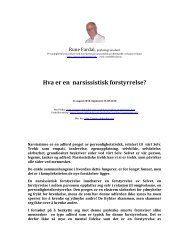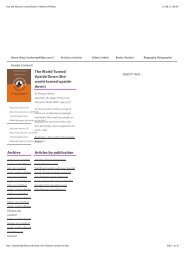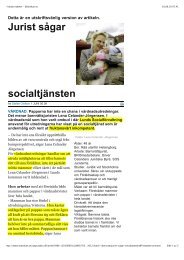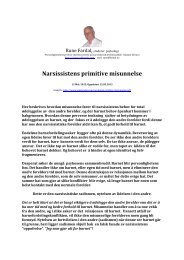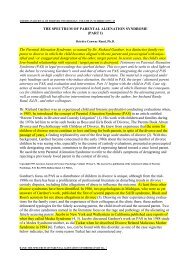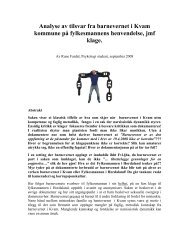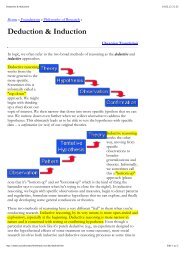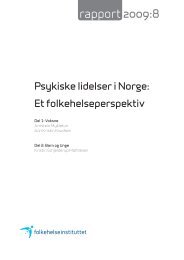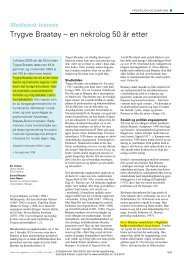The origins of narcissism and narcissistic personality disorder a
The origins of narcissism and narcissistic personality disorder a
The origins of narcissism and narcissistic personality disorder a
Create successful ePaper yourself
Turn your PDF publications into a flip-book with our unique Google optimized e-Paper software.
64 JOHN S. AUERBACH<br />
tz<strong>of</strong>f & Borton, 1979), for example, infants identified visually a nipple<br />
they had sucked while blindfolded <strong>and</strong> differentiated it from another<br />
nipple, with which they had had no experience, provided as a distractor.<br />
Infants at this age can also correlate light intensity with sound<br />
intensity (Lewkowicz& Turkewitz, 1980). In fact, the capacity for crossmodal<br />
equivalence in infants is so sophisticated that 3-week-olds can<br />
imitate the tongue <strong>and</strong> mouth movements <strong>of</strong> adult models (Meltz<strong>of</strong>f<br />
& Moore, 1977) <strong>and</strong> 2-day-olds can imitate an adult’s affective facial<br />
expressions (Field, Woodson, Greenberg, & Cohen, 1982). While these<br />
imitations are not the same as the intentional imitations described by<br />
Piaget (1945/1962), they nevertheless indicate that infants can correlate<br />
body transformations that they can see with body transformations<br />
that they cannot see but can perceive through proprioception.<br />
Neonatal infants also have striking memorial capacities. For example,<br />
neonates who were exposed during the last trimester <strong>of</strong> pregnancy to<br />
their mothers’ reading a passage from Dr. Seuss not surprisingly preferred<br />
hearing their mothers’ voices, rather than those <strong>of</strong> other adult<br />
women (see DeCasper & Fifer, 1980), but also preferred listening to<br />
their mothers read the material they had heard in utero over hearing<br />
their mothers read a different passage (DeCasper & Spence, 1986). In<br />
a cued-recall study (Greco, Rovee-Collier, Hayne, Griesler, & Earley,<br />
1986), infants less than 3 months old demonstrated an ability to remember<br />
contingencies between their body movements <strong>and</strong> the movements<br />
<strong>of</strong> a mobile they had kicked some 1 to 3 weeks after the initial<br />
exposure. Infants less than 2 months old can remember specific objects<br />
in a training mobile for up to 24 hours (Hayne, Greco, Earley, Griesler,<br />
& Rovee-Collier, 1986). <strong>The</strong>se remarkable perceptual <strong>and</strong> memorial<br />
capacities suggest that infants in the first 2 months <strong>of</strong> life have a presymbolic<br />
representational capacity founded on the storage <strong>of</strong> distinctive<br />
features <strong>of</strong> stimuli (Beebe & Lachmann, 1988; Meltz<strong>of</strong>f, 1985; Stern,<br />
1985).<br />
Formation <strong>of</strong> a core self. Between the second <strong>and</strong> sixth months<br />
<strong>of</strong> life, according to Stern (1985), infants use these early cognitive<br />
abilities to extract from their daily experiences a set <strong>of</strong> self-invariantsthat<br />
is, construct a core self. <strong>The</strong>se invariants are agency, self-coherence,<br />
self-affectivity, <strong>and</strong> self-history (memory). Numerous other infancy<br />
researchers (e.g., Emde, Gaensbauer, & Harmon, 1976; Piaget,<br />
1936/1963; S<strong>and</strong>er, 1962; Spitz, 1965) have noted that infants undergo




